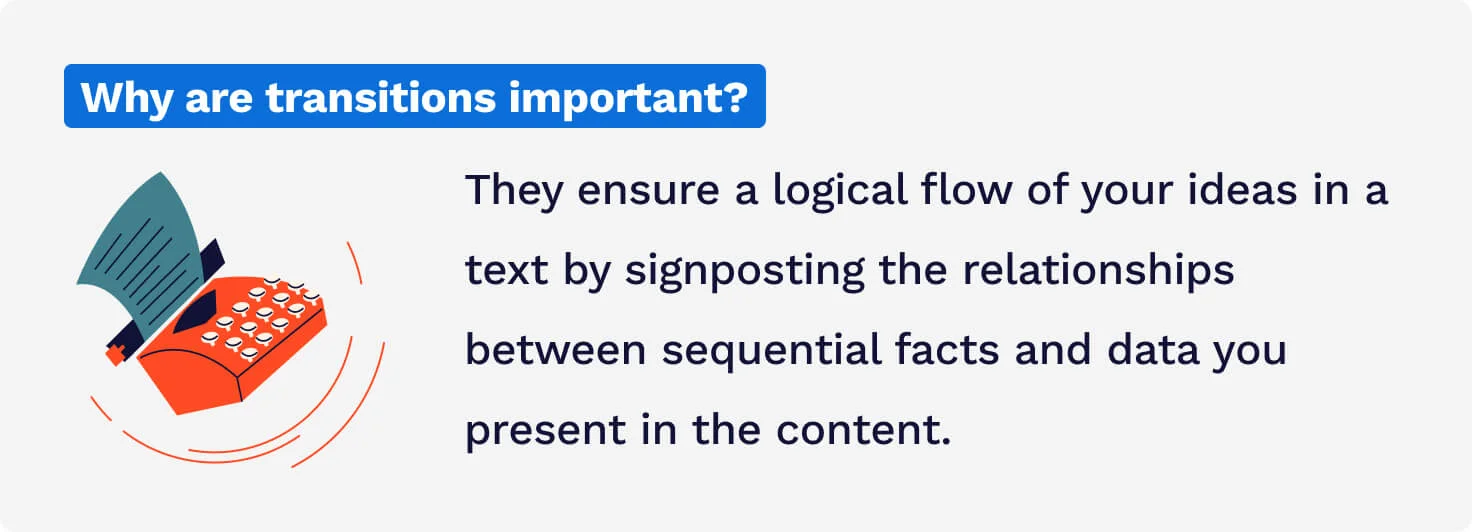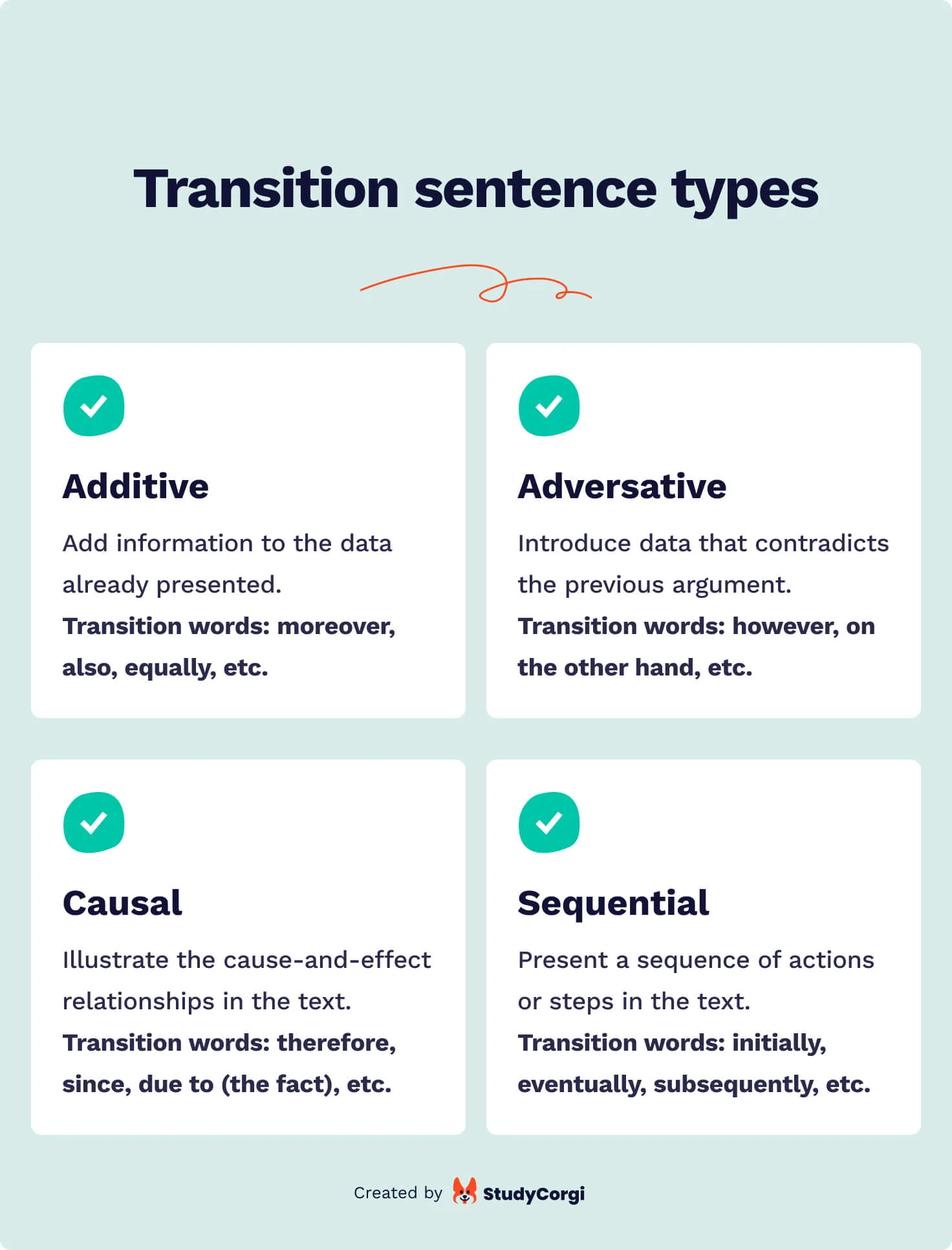📝 Transition Sentence Maker – How to Use It?
Chunky content is very hard to read, spoiling the overall impression and reducing your grades. A good way to counter this problem is to add transitions to your essay, such as starters, logical links between sections, and concluding transitions.
If you’re unsure of how to write transition sentences correctly and effectively, here is our automated and smart transition sentence maker. It can help you with any transition-related task and improve the flow of your essay for better readability and impact.
Take these steps to use the tool:
- Select what you need it to do: add transitional sentences to your text or show suitable transition phrase examples.
- Add the required information: paste your essay or select what transition phrase ideas you wish to be demonstrated.
- Push the button and enjoy the result.
👌 The Benefits of This Transition Sentence Maker
So, how can our transition sentence generator help you out?
Here are the key benefits of this creator you’re sure to enjoy:
🎓 Transitional Sentences in Academic Writing
Transitional sentences ensure a logical flow of your ideas in a text by signposting the relationships between sequential facts and data you present in the content.
This way:
They can be seen as bridges between one fact and another or a link between the external evidence you’ve cited from a published source and your interpretation of that data.

Here is an illustration of how a transition sentence functions in the context:
Environmental problems rise year by year as the tempos of human consumption don’t slow down. However, together with the consumption volumes rises social awareness of environmental issues. People have started investing money in ecological initiatives, the development of renewable energy programs, waste recycling, and many other steps to mitigate the disastrous human footprint.
Here, as you can see, the second sentence smoothens the transition from an idea about the rising magnitude of human impact on the ecology to a discussion of human efforts to offset that impact.
🤔 Where to Place Transition Sentences?
As a rule, transitions are used to signpost a movement from one idea to another one, so they are used between various parts of an academic writing piece:
✍️ How to Make Transition Sentences?
In a nutshell, a good transition should clarify the relationship between your ideas in the text. Without transitions, any text will look chunky and abrupt, which is hard to read and make sense of.
So:
It’s impossible to dedicate a complete text to one idea only, and you need smooth transitions that guide your readers like a compass and let them trace the line of your argument consistently.
In other words:
Transition sentences make texts clear and user-friendly; you can turn any sentence into a transition unit by adding transition phrases meant for specific linking purposes.

Here are some examples for your guidance.
Additive Transition Sentence Examples
As the name suggests, additive transition sentences are needed to add information to the data bits you’ve already presented and to show that they support each other.
Here is an example of adding data in the context:
Students coming to live on campus can face many unexpected challenges at the start of their studies. They may feel homesick and be not adapted to independent living. Moreover, they may experience problems with the organization of home duties and the study process. This lack of time and routine management can result in low grades during the first year of studies.
As you can see in this example, the second sentence adds some context to the discussion of first-year students and creates a logical basis for the concluding sentence.
Adversative Transition Sentence Examples
Adversative transitions are used when the author needs to introduce data that contradicts the previous argument or adds new data that illustrates the discussed object from another perspective.
Here’s how it works in context:
Sleep quality is a vital parameter of people’s well-being and health. However, healthy sleep without interruptions is impossible without proper nutrition and a drinking schedule. Your organism will be unable to restore fully if you haven’t consumed the right nutrients on the previous day, and you may feel a lack of energy and refreshment the next morning.
In this paragraph, an adversative transition sentence was used to add new data to the importance of high-quality sleep, followed by a more extended discussion of the role of nutrition and water in a person’s well-being.
Causal Transition Sentence Examples
Causal transitions are meant to illustrate the causal relationships between data in the text. They should be used carefully, as a wrong causal relationship may confuse the readers and reduce readability.
Here’s how it works:
Mental health issues take some time and a combination of factors to develop. At first, the person may not feel any health problems but suffer from insomnia or anxiety. If no steps are taken at this stage, people may suffer from greater anxiety levels that grow into panic attacks or phobias. Once these symptoms start manifesting, it’s mandatory to seek mental health counseling and develop a treatment plan with a medical specialist.
Sequential Transition Sentence Examples
Sequential transitions are a great way to present a sequence of actions or steps in the text. They allow the readers to understand that the discussion of the previous step has ended, and the author proceeds to the next stage.
Here’s an example of this transition sentence type:
To cook pancakes, you need to combine the dry ingredients first. Combine flour, salt, sugar, and sodium in a bowl and mix it all well to achieve an even texture. Next, it’s time to add the liquid ingredients. First comes the egg; it should be mixed into the dough well before proceeding to the next stage.
How to Write a Conclusion Transition Sentence?
A conclusion transition sentence usually starts with a concluding transition phrase, like “to sum up the presented evidence” or “summing up,” followed by a restated thesis statement. This way, the author shows to the readers that they have started the conclusion part.
Thank you for reading this article! If you’re looking for transitional words and phrase ideas, check the tools we’ve developed:
Updated: